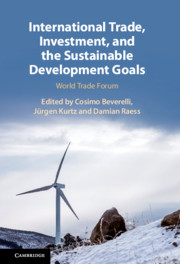Book contents
- International Trade, Investment, and the Sustainable Development Goals
- International Trade, Investment, and the Sustainable Development Goals
- Copyright page
- Contents
- Figures
- Tables
- Contributors
- Preface
- Introduction
- Part I Penetration and Diffusion of the Sustainable Development Goals
- 1 A Cross-Cutting Legal Analysis of the European Union Preferential Trade Agreements’ Chapters on Sustainable Development
- 2 The European Union’s New International Investment Policy and the United Nation’s Sustainable Development Goals
- 3 Natural Resources Management in the Sustainable Development Goals Era
- Part II Top-Down: Public Approaches to Achieving the Sustainable Development Goals
- Part III Bottom-Up: Private Sector and Civil Society Initiatives on the Sustainable Development Goals
- Index
- References
2 - The European Union’s New International Investment Policy and the United Nation’s Sustainable Development Goals
Integration as a Motor of Substantive Policy Change?
from Part I - Penetration and Diffusion of the Sustainable Development Goals
Published online by Cambridge University Press: 18 September 2020
- International Trade, Investment, and the Sustainable Development Goals
- International Trade, Investment, and the Sustainable Development Goals
- Copyright page
- Contents
- Figures
- Tables
- Contributors
- Preface
- Introduction
- Part I Penetration and Diffusion of the Sustainable Development Goals
- 1 A Cross-Cutting Legal Analysis of the European Union Preferential Trade Agreements’ Chapters on Sustainable Development
- 2 The European Union’s New International Investment Policy and the United Nation’s Sustainable Development Goals
- 3 Natural Resources Management in the Sustainable Development Goals Era
- Part II Top-Down: Public Approaches to Achieving the Sustainable Development Goals
- Part III Bottom-Up: Private Sector and Civil Society Initiatives on the Sustainable Development Goals
- Index
- References
Summary
This chapter assesses whether the EU’s recent empowerment to conclude international investment agreements has made these agreements more development-friendly. Focusing on the EU’s choice of partner countries, substantive protection and treatment provisions as well as procedural provisions on investor-to-state dispute settlement, the chapter finds that the EU’s international investment agreements (IIAs) have indeed become more development-friendly in comparison to the international investment agreements of EU member states. They strengthen state interests vis-à-vis investor interests. The chapter tests whether these policy changes are due to European law obligations applying to EU international investment agreements, increased politicisation of IIA policy-making in the context of EU’s Common Commercial Policy, or the aggregation of diverse member state preferences into a common European approach. It finds that politicisation and aggregation of member state preferences primarily fuelled policy changes while legal obligations played no significant role. From a theoretical perspective, the chapter lends support to rational choice institutionalism, which suggest that institutional changes affect policy substance.
Keywords
- Type
- Chapter
- Information
- International Trade, Investment, and the Sustainable Development GoalsWorld Trade Forum, pp. 50 - 75Publisher: Cambridge University PressPrint publication year: 2020

